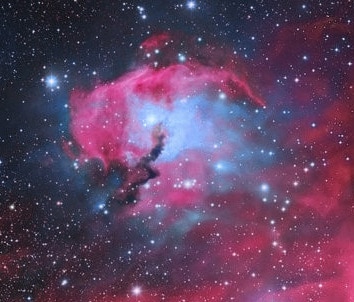Create a free profile to get unlimited access to exclusive videos, sweepstakes, and more!
A Seagull Flies on a Dusty Ion Wind

Robert Gendler is an astrophotographer whose work I’ve featured here many times (he helped assemble a jaw-dropping Hubble Andromeda galaxy picture, for example). One area in which he excels is taking data from multiple big telescopes and merging them to create new views of the heavens.
His latest is a stunner: the aptly named Seagull Nebula:
Can you see the shape of a gull in that? The head is the knot of gas to the left, and the wing shape is obvious enough. In this photo it actually looks more like a parrot to me, but that’s OK. A bird in the hand …
This is actually a vast star-forming region, a huge factory of gas and dust that is collapsing in various places to create newborn stars. Many of these stars are massive and hot, shining blue. They heat the gas up, exciting it (as we say in astronomy); the cloud is mostly hydrogen, which glows a characteristic pinkish-red when flooded by this starlight.
There’s also quite a bit of dark dust in this cloud, opaque to visible light. But the stars are so bright their light can reflect off it, and you see blue fuzz. The head of the gull is a lovely combination of both emission (red) and reflection (blue) nebulae.
Some features of the nebulae were puzzling me, so I poked around to look for other images and found this one taken by NASA’s Wide-field Infrared Explorer:
The overall shape is the same, but there are big differences. This image is taken in the far-infrared, where the normally opaque dust glows. It’s actually a bit tough to match up features, since stars that are cool and faint in Gendler’s photo blaze away in the WISE image (and the WISE image is rotated clockwise slightly compared to the visible light image). Worse, what’s dark in Gendler’s image is bright in the WISE image, but some places are bright in both.
But note the bright blue star (called vdB 95) in the top image, located near the center bottom; it’s the brightest star in the field. See the fuzzy ring directly around it? I thought that was a reflection from inside the telescope (which is what causes the larger, sharper but fainter blue halo around it). It turns out that ring is real! You can see it in the WISE image, as well as a red arc. I suspect that star is moving at high speed through the gas and dust, and also blowing off a wind of material (like the Sun’s solar wind). That commonly causes such arc-like features in WISE images. Phenomenal.
Comparing the two, you can see other regions where stars are buried in gas and dust, and therefore are probably very young, still ensconced in their birth cocoons of material. As those stars age, their winds of subatomic particles and ultraviolet light will eat away at the dust, blowing it out, creating cavities in the nebula. Eventually the stars will wander out and travel the galaxy on their own. Thinking of them as chicks leaving the nest seems apropos for the whole theme here.
It’s possible our Sun was born in a cloud like this, our siblings and the nursery long since gone. I love soaking in the beauty of objects like this, but it’s hard not to stop and wonder that once, eons ago, we too were literally part of something like this.


























